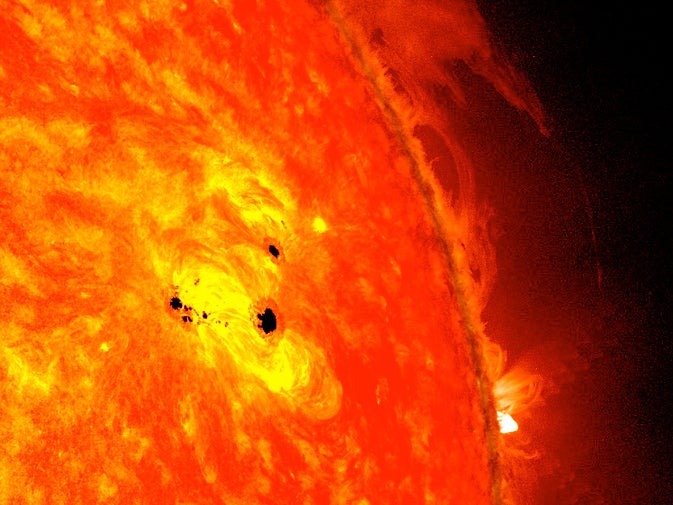Solar flares: what are they, what causes them, and how dangerous are they to humans?
Flights, communication technology, and global positioning systems could all be affected by huge solar flares

Your support helps us to tell the story
From reproductive rights to climate change to Big Tech, The Independent is on the ground when the story is developing. Whether it's investigating the financials of Elon Musk's pro-Trump PAC or producing our latest documentary, 'The A Word', which shines a light on the American women fighting for reproductive rights, we know how important it is to parse out the facts from the messaging.
At such a critical moment in US history, we need reporters on the ground. Your donation allows us to keep sending journalists to speak to both sides of the story.
The Independent is trusted by Americans across the entire political spectrum. And unlike many other quality news outlets, we choose not to lock Americans out of our reporting and analysis with paywalls. We believe quality journalism should be available to everyone, paid for by those who can afford it.
Your support makes all the difference.Solar flares are enormous explosions of energy that are released from the Sun.
It takes only a few minutes for these intense bursts of radiation to reach millions of degrees, and their effects can be devastating – causing blackouts and interfering with satellites.
What are solar flares?
Solar flares are essentially giant explosions on the surface of the sun, with the amount of energy that they release being equivalent to millions of nuclear bombs detonating simultaneously. These can last from minutes to hours, and are usually seen by scientists through x-rays and optical light.
As Solar flares extend to the outer layer of the Sun, known as the corona, which consists of rarefied gas that reaches temperatures of up to 100 million degrees.
Are there different types of solar flare?
Flares are rated between four classifications, between background-level A-class flares, followed by B, C, M, and X-class which are the largest flares; similar to the Richter scale, each letter is tenfold more powerful than its previous, meaning an M-class flare is ten times greater than a C-class.
The most powerful solar flare in four years was expelled by the Sun in December 2020.
How often do they happen?
Solar flares happen at different times depending on what stage of the solar cycle – an 11-year calendar of the Sun’s activity - the flaming ball of gas is currently in, with the star moving regularly from quiet to active and back to quiet.
Those periods of activity are known as solar weather, and while their changes have been watched for hundreds of years, many of their processes and effects remain largely mysterious.
Around the solar maximum, many solar flares can occur during the same day, while during the solar minimum flares could burst into life as often as once per week.
The first solar flare rcorded happened on 1 September 1859, spotted by scientists Richard C. Carrington and Richard Hodgson.
What causes solar flares?
Solar flares are caused when magnetic field lines from sunspots – the darker, cooler regions of the sun – tangle up and erupt. Despite being the cooler part of the sun, they can still be extremely hot and reach temperatures of 1,800 degrees Celcius. The magnetic energy that has been built up in the solar atmosphere is suddenly released, emitted across the entire electromagnetic spectrum.
Are we in any danger?
Strong solar flares can send huge clouds of plasma into space. This is known as a coronal mass ejection (CMEs), and when they hit the Earth they can cause geomagnetic storms and intense aurora. However, most CMEs are not associated with flares, the ESA notes.
For some of the largest, X-class flares, these can trigger radio blackouts, but they are incredibly rare, while medium M-class flares can cause brief radio blackouts.
Large geomagnetic storms have, in the past, caused power outages and damaged communication satellites. The energy particles can also be damaging to electronic equipment and astronauts or passengers in high-flying aircraft.
Approximately 7,500 polar routes are taken by airlines every year, Nasa says, and when the flight paths cross to latitudes where satellite communication cannot be used, crews must use high-frequency radio to communicate. During certain space weather events, the density of ionised gas can increase and affect these radio communications.
However, there are some caveats to whether these ejections will strike the Earth. Solar flares only impact the Earth when the occur on the side of the Sun facing the planet; because the flares are made of protons, if scientists can see it, then the Earth could be affected.
Moreover, the Earth’s own magnetic shield acts as protection for the planet – deflecting the radiation and preventing most of it from having an effect on the surface.
That said, with increasing technology, human beings are increasingly more at risk through indirect effects.
"What’s at stake," the Space Weather Prediction Center’s Tom Bogdan told National Geographic, "are the advanced technologies that underlie virtually every aspect of our lives."
Global positioning systems and the electrical grid are the greatest risk, as power surges can blow out the transformers. These can take time, and cost, to replace – and that is only exacerbated if many are destroyed at once.
"Imagine large cities without power for a week, a month, or a year," Daniel Baker, of the University of Colorado’s Laboratory for Atmospheric and Space Physics, said. "The losses could be $1 to $2 trillion, and the effects could be felt for years."
Join our commenting forum
Join thought-provoking conversations, follow other Independent readers and see their replies
Comments